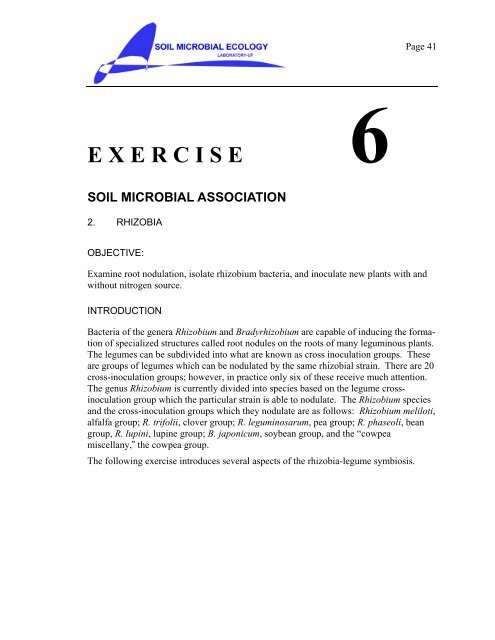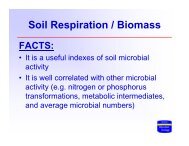Soil Microbial Ecology - Soil Molecular Ecology Laboratory
Soil Microbial Ecology - Soil Molecular Ecology Laboratory
Soil Microbial Ecology - Soil Molecular Ecology Laboratory
Create successful ePaper yourself
Turn your PDF publications into a flip-book with our unique Google optimized e-Paper software.
Page 41<br />
E X E R C I S E<br />
6<br />
SOIL MICROBIAL ASSOCIATION<br />
2. RHIZOBIA<br />
OBJECTIVE:<br />
Examine root nodulation, isolate rhizobium bacteria, and inoculate new plants with and<br />
without nitrogen source.<br />
INTRODUCTION<br />
Bacteria of the genera Rhizobium and Bradyrhizobium are capable of inducing the formation<br />
of specialized structures called root nodules on the roots of many leguminous plants.<br />
The legumes can be subdivided into what are known as cross inoculation groups. These<br />
are groups of legumes which can be nodulated by the same rhizobial strain. There are 20<br />
cross-inoculation groups; however, in practice only six of these receive much attention.<br />
The genus Rhizobium is currently divided into species based on the legume crossinoculation<br />
group which the particular strain is able to nodulate. The Rhizobium species<br />
and the cross-inoculation groups which they nodulate are as follows: Rhizobium meliloti,<br />
alfalfa group; R. trifolii, clover group; R. leguminosarum, pea group; R. phaseoli, bean<br />
group, R. lupini, lupine group; B. japonicum, soybean group, and the “cowpea<br />
miscellany,” the cowpea group.<br />
The following exercise introduces several aspects of the rhizobia-legume symbiosis.





